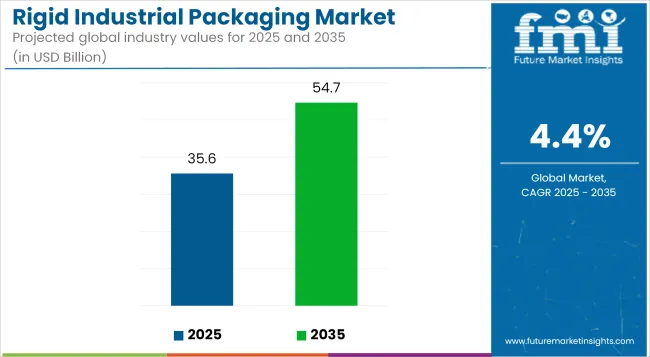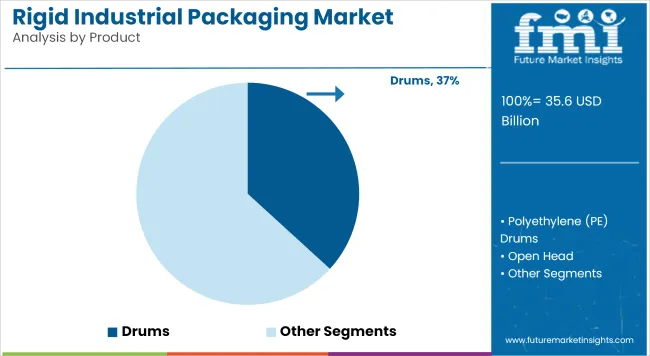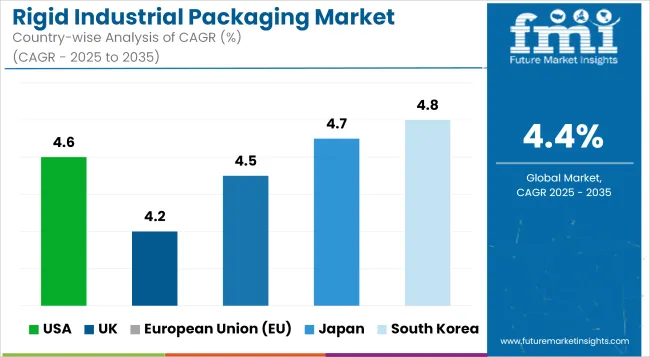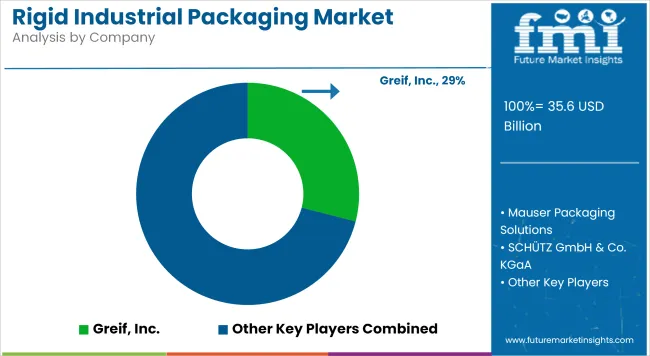The rigid industrial packaging market is projected to grow from USD 35.6 billion in 2025 to USD 54.7 billion by 2035, registering a CAGR of 4.4% during the forecast period. Growth has been driven by increasing global trade, stringent regulations concerning the safe transport of hazardous goods, and the expansion of industrial manufacturing across Asia Pacific and North America.

| Metric | Value |
|---|---|
| Market Size in 2025 | USD 35.6 billion |
| Projected Market Size in 2035 | USD 54.7 billion |
| CAGR (2025 to 2035) | 4.4% |
Market resilience has also been evidenced through consumer preference for reusable and durable packaging. Strength of this sector has been noted in the steady rise of industrial infrastructure and logistics networks, enabling reliable distribution of bulk materials under regulated standards.
The rigid industrial packaging market has been notably shaped by the growing need for durable, reusable, and regulation-compliant packaging solutions across a wide range of industrial sectors. Developments in material engineering have enabled the production of rigid containers such as drums, intermediate bulk containers (IBCs), and pails that ensure the safe handling and transport of hazardous, bulky, or sensitive goods. Additionally, innovations in reconditioning technologies and lightweight metal or high-performance plastic materials have supported the emergence of more sustainable and cost-efficient packaging formats.
The rigid industrial packaging industry is poised for continued expansion, driven by global trade growth, rising safety regulations, and the increasing demand for reusable bulk packaging. Market dynamics suggest an accelerating shift toward circular economy models, where container reusability and life-cycle optimization will define value.
Companies investing in automation, smart tracking systems, and modular design enhancements are expected to lead the competitive landscape, particularly as industries prioritize operational efficiency, compliance, and environmental responsibility.
The Rigid Industrial Packaging Market is segmented by product type, capacity, and end-use application. By product type, the market includes drums, rigid Intermediate Bulk Containers (IBCs), pails, and jerry cans. In terms of capacities, drums are available in standard 55 gallons (210 liters) and customized sizes with variations such as open head, tight head, polyethylene (PE) drums, and metal drums.
Rigid IBCs are offered in standard sizes ranging from 1,040 liters (275 US gallons) to 1,250 liters (330 US gallons), including new, reconditioned, rebottled, and washed IBCs. Pails come in plastic and metal variants, with capacities ranging from up to 5 liters to above 30 liters, while jerry cans are also available in plastic and metal options with various volume sizes.
The market serves diverse end-use industries including petrochemicals and lubricants, industrial chemicals, paints, inks and dyes, agricultural chemicals, automotive, building and construction, food and beverage, pharmaceuticals, and others. Regionally, the market spans North America, Latin America, Europe, Asia-Pacific, and the Middle East & Africa, driven by industry-specific demands and regulatory trends.
Rigid Intermediate Bulk Containers (IBCs) are anticipated to hold 29.4% of the market share by 2025, driven by their ability to safely transport and store large volumes typically between 275 to 330 gallons of liquids, pastes, and solids in a compact footprint.
These containers are widely used in sectors such as chemicals, pharmaceuticals, beverages, and paints & coatings. Rigid IBCs typically consist of a blow-molded HDPE inner bottle enclosed in a galvanized steel cage. Their durability and stack ability reduce warehouse footprint, while the standardized pallet base enables compatibility with forklifts and containerized freight.
The rebottled and reconditioned IBC segment has seen notable growth due to its cost-efficiency and environmental benefits. Manufacturers have introduced UN-certified composite IBCs for dangerous goods, fitted with tamper-evident seals, quick-drain valves, and anti-static coatings. Return logistics and closed-loop IBC rental programs have gained traction, especially in North America and Europe, aligning with corporate sustainability targets to reduce single-use industrial packaging.
Drums are projected to account for 36.8% of the rigid industrial packaging market by 2025, remaining indispensable for storing and transporting liquids, powders, and semi-solids across the chemical, food, and oil & gas industries. These containers are highly valued for their strength, stack ability, and ability to withstand mechanical stress during long-haul transport.
Plastic drums, particularly those made from high-density polyethylene (HDPE), dominate due to their excellent chemical resistance, non-reactive surfaces, and relatively lightweight profile. These are extensively used for acids, detergents, and food-grade materials.
Steel drums, on the other hand, are preferred in industrial segments requiring flame resistance, high strength, and permeability such as in solvents, coatings, and petroleum derivatives. Dual-layer and multi-ring reinforced drum designs have been introduced to meet UN packaging codes, while removable liners are now being used for improved cleanliness and reusability. With rising global trade in hazardous and temperature-sensitive goods, demand for tamper-proof closures and GPS-tracked shipments has seen increased adoption in this segment.

High Manufacturing Costs and Raw Material Price Volatility
Increased prices of raw materials such as wood, metals, plastic and many more are harming the growth of the industry. Unstable crude oil prices, which are used to create plastics, directly affect the price of plastic-based packaging, and its price increases as demand for sustainable materials grows and metals are in short supply.
Moreover, government regulations imposed against material sourcing, waste management, and recycling mandate additional expenditures on operations. From financial struggles, businesses need to ensure cost-effective production methods, alternative raw materials, and effective supply chain management.
Environmental Regulations and Sustainability Concerns
The rising focus on environmental sustainability acts as a challenge for the rigid industrial packaging makers. Regulatory regimes such as the EU Packaging Waste Directive or Extended Producer Responsibility (EPR) laws require higher recyclability and lower carbon footprints.
Traditional rigid packaging, and plastic-based solutions in particular, come under fire for their environmental footprint. This is why companies should innovate and create biodegradable, reusable and recyclable packing material with energy-saving production methods, to meet the changing environmental standards.
Growing Demand for Durable and Sustainable Packaging Solutions
The growth of the market is also attributed to the booming chemical, food & beverages, and pharmaceuticals sector, leading to high demand for durable and sustainable packaging. Businesses look for packaging solutions that need to take product protection a step further by ensuring an extended shelf life and less product waste.
Because of the rise of reusable rigid containers like Intermediate Bulk Containers (IBCs) and plastic drums, manufacturers can catch customers who are looking for sustainability. Eco-friendly materials, lightweight designs, and circular economy initiatives will continue to be key areas of investment that will improve market competitiveness.
Expansion of Industrial and E-Commerce Sectors
The growth of industrial applications and e-commerce logistics at a rapid pace, is likely to open up new avenues for the rigid industrial packaging market. The need for more advanced and impact-resistant packaging drives the increase in global trade, growing consumer demand, and innovation in the supply chain.
With the advent of automated packaging solutions, smart tracking systems, and tamper-evident packaging technologies, the market will evolve even more. Companies embracing digital packaging innovations, implementing RFID-enabled tracking, and driving automation will position themselves ahead in the competitive landscape.
Changes in the rigid industrial packaging market from 2020 to 2024 and market trends (2025 to 2035): The rigid industrial packaging market has witnessed growth owing to high demand from industries such as chemicals, agriculture, and pharmaceuticals between 2020 and 2024.
Innovation was fueled by heightened attention to product safety, resilient supply chains, and recyclable materials. Nonetheless, variances in raw material prices, regulatory hindrances, and disruptive logistics threw market stability into disarray.
By 2025 to 2035: Industry Disruption redefining the packaging future due to Smart Packaging, Digital Supply Chain, Circular Economy. AI-driven packaging optimization, usages of eco-friendly composites, and blockchain-enabled tracking will become the trend and enhance efficiency and sustainability. Market growth and global competitiveness will be spurred by companies investing in automation, material science innovations, and regulatory compliance.
Chemical, pharmaceuticals and food & beverage are some of the most important industries thriving in the rigid industrial packaging market in the USA The rising demand for durable and sustainable packaging solutions is driving the growth of the rigid packaging market which includes, drums, IBCs (Intermediate Bulk Containers), and rigid plastic containers.
Moreover, growing awareness regarding recyclability and regulatory implementations to stimulate sustainable packaging is adding impetus to market growth. Key manufacturers in the region, along with technology advancements in the packaging sector, are also driving the growth of the market in the region.
| Country | CAGR (2025 to 2035) |
|---|---|
| USA | 4.6% |
The UK Rigid Industrial Packaging Market has been witnessing steady progress due to surging industrial activities in the country and stringent environmental regulations imposed by the government. In fact, firms are adopting sustainable and reusable rigid packaging products to minimize carbon footprints.
The chemical and automotive industries are also contributing to the demand for industrial bulk packaging. Also, solution such as barrier coatings and smart packaging solutions further improve the longevity and efficiency of rigid containers, which is expected to contribute toward their market penetration.
| Country | CAGR (2025 to 2035) |
|---|---|
| UK | 4.2% |
Stringent packaging regulations, increased trade, and growing demand for sustainable packaging solutions are driving the growth of the rigid industrial packaging market in the European Union. Germany, France and Italy are active to embrace rigid packaging products in various sectors, including chemicals, food processing, and manufacturing.
The quest to eliminate plastic waste and improve the ability to recycle industrial packaging materials is shaping market trends. Rigid packaging options with better performance, lower weight, and more sustainable materials are being developed by companies.
| Country | CAGR (2025 to 2035) |
|---|---|
| European Union (EU) | 4.5% |
Japan's unwavering environment packaging market includes high popularity for technologically advanced and also eco-friendly packaging services. In recent years, a focus on precision manufacturing and quality materials has driven innovation in rigid packaging in the electronics and pharmaceutical sectors.
Increasing adoption of smart packaging solutions embedded with RFID tracking and tamper-evident features is predicted to further enhance product safety and compliance with global standards. Moreover, trends for light, yet robust rigid packaging is applied to market expansion.
| Country | CAGR (2025 to 2035) |
|---|---|
| Japan | 4.7% |
The inflexible industrial packaging market in South Korea is rising as well amid fast industrialization and increasing exports of chemical products and food. Such factors are driving the demand for efficient and sustainable bulk packaging solutions like the metal drums and IBCs.
Smart tracking technologies are integrated into rigid packaging, improving supply chain efficiency. Key manufacturers and governmental regulations that encourage sustainable packaging materials also contribute to the growth of the market.

| Country | CAGR (2025 to 2035) |
|---|---|
| South Korea | 4.8% |
Rising demand from chemical, pharmaceutical, food & beverages, and oil & gas industries are boosting the growth of the rigid industrial packaging market. Market growth is being driven by the increasing demand for durable, leak-proof and high-strength packaging solutions to transport and store both hazardous and non-hazardous materials.
Enhancements in material technologies such as high-density polyethylene (HDPE), metal, and composite-based containers helped improve packaging efficiency, safety, and sustainability. Further, increasing emphasis toward the development of recyclable and reusable rigid packaging solutions is also accelerating the market, as organizations targeted to meet strict environmental regulations and minimize carbon footprints.
Moreover, manufacturers are implementing smart packaging solutions like RFID tracking and tamper-evident seals to enhance logistics efficiency and product security. Growing global trade activities and strict safety compliance standards are expected to spur innovative spirit of industrial drums, IBCs (Intermediate Bulk Containers) & rigid pails to deliver desired storage and transport solutions.

Other Key Players
The overall market size for rigid industrial packaging market was USD 35.6 billion in 2025.
The rigid industrial packaging market expected to reach USD 54.7 billion in 2035.
Growing chemical and pharmaceutical industries, rising demand for durable packaging, increasing global trade, expanding e-commerce logistics, and advancements in sustainable packaging materials will drive market demand.
The top 5 countries which drives the development of rigid industrial packaging market are USA, UK, Europe Union, Japan and South Korea.
Advancements in material innovation driving market growth to command significant share over the assessment period.






Full Research Suite comprises of:
Market outlook & trends analysis
Interviews & case studies
Strategic recommendations
Vendor profiles & capabilities analysis
5-year forecasts
8 regions and 60+ country-level data splits
Market segment data splits
12 months of continuous data updates
DELIVERED AS:
PDF EXCEL ONLINE
Latin America Rigid Industrial Packaging Market Size and Share Forecast Outlook 2025 to 2035
Rigid Foam Market Forecast Outlook 2025 to 2035
Rigid Box Market Forecast and Outlook 2025 to 2035
Rigid Sleeve Boxes Market Size and Share Forecast Outlook 2025 to 2035
Rigid Food Containers Market Size and Share Forecast Outlook 2025 to 2035
Rigid IBC Market Size and Share Forecast Outlook 2025 to 2035
Rigid-Flex PCB Market Size and Share Forecast Outlook 2025 to 2035
Rigid Metal Electrical Conduit Market Size and Share Forecast Outlook 2025 to 2035
Competitive Overview of Rigid IBC Market Share
Breaking Down Market Share in Rigid Food Containers
Rigid Tray Market from 2024 to 2034
Rigid Colored PU Foam Market
Rigid Packaging Containers Market Insights – Growth & Forecast 2024-2034
Rigid Food Packaging Market Size, Share & Forecast 2025 to 2035
FFS Rigid Films Market Size and Share Forecast Outlook 2025 to 2035
Market Share Insights of FFS Rigid Film Manufacturers
Luxury Rigid Box Market Size and Share Forecast Outlook 2025 to 2035
Market Share Breakdown of Luxury Rigid Box Manufacturers
Plastic Rigid IBC Market Size and Share Forecast Outlook 2025 to 2035
Galvanized Rigid Conduit Market Size and Share Forecast Outlook 2025 to 2035

Thank you!
You will receive an email from our Business Development Manager. Please be sure to check your SPAM/JUNK folder too.
Chat With
MaRIA